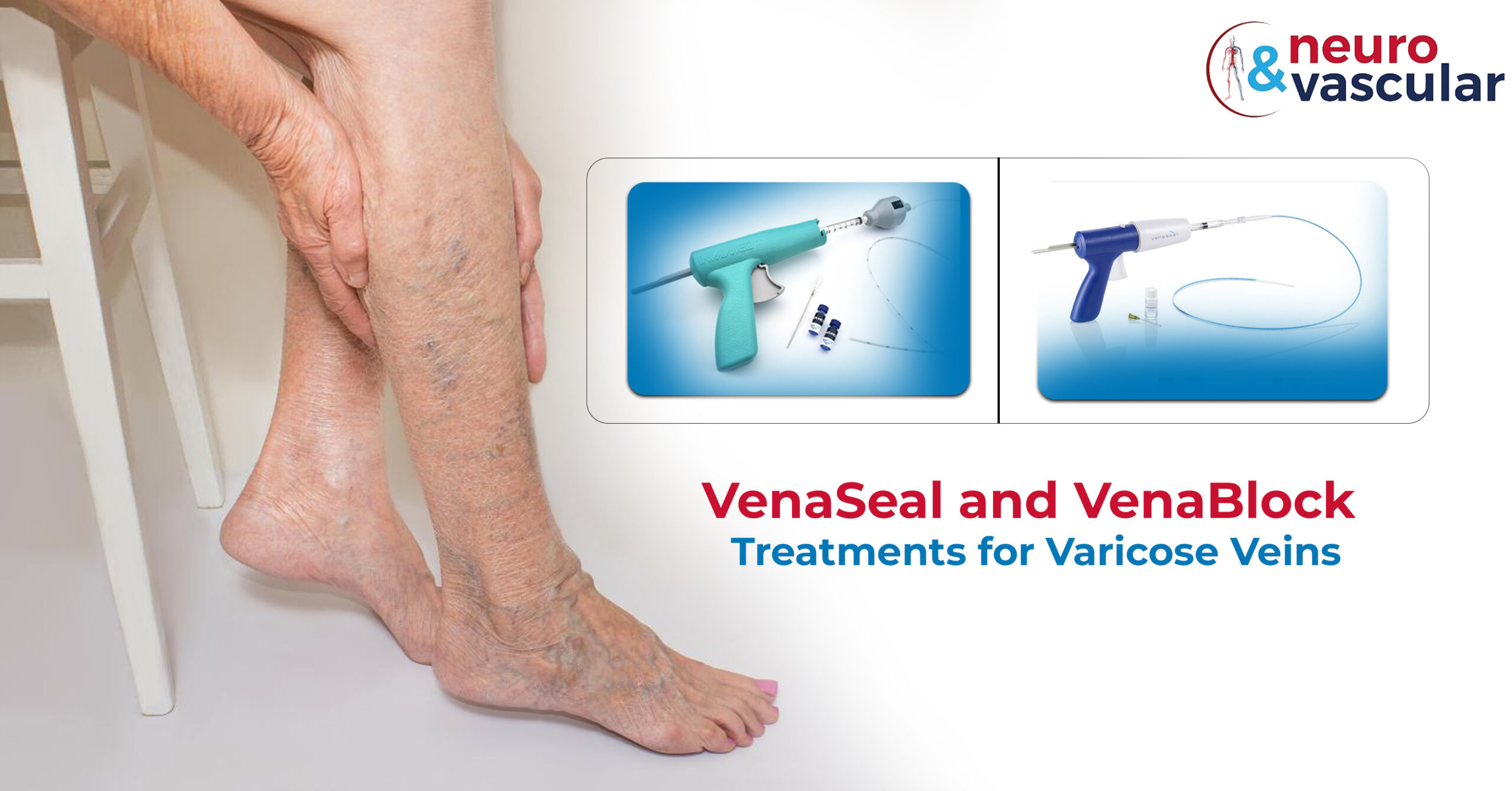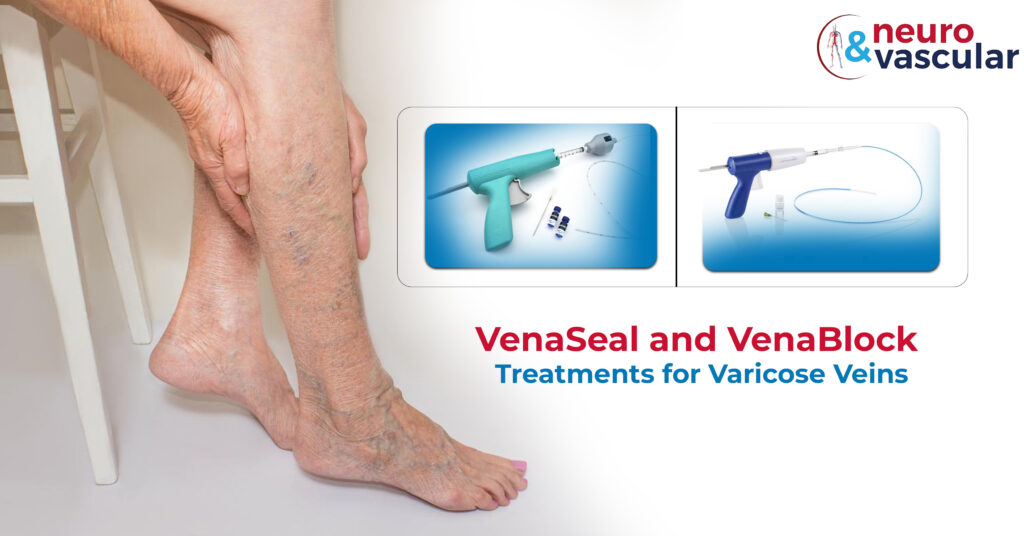
Vena Block & VenaSeal Treatments for Varicose Veins

The most recent development in the treatment of varicose veins is the use of a medical “glue.” This simple method essentially glues the varicose veins together and the body then naturally reroutes the blood through healthy veins in the area while reabsorbing the closed vein. The vein disappears due to reabsorption.
In order to treat the veins with damaged valves, a specific kind of “superglue” is used. Similar to endothermic ablation (EVLA), which shuts off the veins by applying strong heat, or similar to surgical “vein stripping,” the glue performs to close varicose veins.
There are two types of super glue techniques to treat varicose veins.
They are:
- Venablock
- Venaseal
What is Vena Block?
Vena Block offers a unique treatment for venous insufficiency. Vena Block is used in the treatment of varicose veins where a medical adhesive is injected into the diseased vein in the leg under ultrasound guidance. This “glue” seals the vein and causes it to harden, heal, and be absorbed by the body. There is no risk of nerve damage or skin burns with Vena Block’s medical adhesive closure, unlike heat-based procedures like Endovenous Laser or Radiofrequency Ablation.
Vena Block cyanoacrylate glue is a protected medical grade “Superglue” of the kind that has been utilized for the vast majority of years in different parts of the body to close abnormal vessels. It was only recently made available for treating varicose veins. It has been demonstrated that medical glues like Vena Block are extremely safe to administer, with no adverse long-term effects.
VenaBlock Glue uses a combination of adhesive glue and ultrasound technology to seal larger veins (near the groin) and does not require hospital-to-hospital or general anesthesia. Unlike other endovenous procedures such as laser or radiofrequency, VenaBlock does not require large amounts of anesthesia. Most patients will only require a single injection of local anesthesia for this procedure and will be able to resume normal activities immediately. Other advantages of VenaBlock over Endovenous Laser include fewer needles used during the procedure and no risk of thermal injury to nerves or skin. The success of glue treatments has been shown in studies to be comparable to that of Endovenous laser, it is also a far superior treatment compared to the old stripping operation.
What does Vena Block treat?
Vena Block is a medical adhesive that is used to treat varicose veins in two areas:
- Perforator veins
- The saphenous vein
Must read: A Step-by-Step Guide to DVT Treatment
What happens during a Vena Block Medical Adhesive Closure Procedure?
Treating Perforator Veins:
Duplex ultrasound is used in this procedure to map out the incompetent perforator. A local anaesthetic is used to numb the particular area. The medical adhesive (VenaBlock) is then drawn into a 1ml Syringe (usually about 0.1 to 0.2 mls of VenaBlock Glue), the glue is injected into the perforator vein while the ultrasound probe applies pressure from the outside. This completely seals the perforator, preventing blood from flowing into the superficial varicose veins. Patients are encouraged to walk around immediately following the procedure, and normal routines can almost immediately be resumed. Following the procedure, the vein will harden (a process known as sclerosis) and be gradually absorbed by the body.
Treating the Saphenous Vein:
First, duplex ultrasound is used to map out and assess any diseased veins in this procedure. Then Local anaesthetic is applied to the area to be treated.
Under ultrasound guidance, The Interventional Radiologist inserted a catheter into the problematic vein. The medical adhesive (VenaBlock) is injected into the vein while the ultrasound probe applies pressure from the outside. This completely seals the vein and redirects blood flow to other healthy veins. After ultrasound confirms complete vein closure, the catheter is removed and a single adhesive bandage is applied. This procedure does not necessitate the use of compression stockings or bandages. Patients are encouraged to walk around immediately following the procedure, and normal routines can almost immediately be resumed.
Advantages:
- No need for Tumescent Anaesthesia
- No need for general or spinal anesthesia
- Easy to use compared to endogenous thermal ablation
- Eliminates nerve damage caused by thermal ablation
- No need for compression stockings
- No skin lesions or burn marks after treatment
- Patients can return to work and daily routines immediately
Must read: 6 Vital Indicators of Deep Vein Thrombosis
What is Venaseal?
Similar to Venablock the Venaseal Glue is made of cyanoacrylate. Cyanoacrylate is a clear and free-flowing liquid that is safe and sterile for injection into the vein. VenaSeal procedure is a minimally invasive non-thermal treatment for vein disease and varicose veins. Venaseal is a safe unique and minimally invasive medical adhesive used to treat varicose veins quickly and effectively. It can be used for the permanent treatment of varicose veins that are close to the surface of the skin.
Conclusion:
Overall VenaBlock & VenaSeal are excellent varicose vein therapy that has been shown to be equally as successful in treating varicose veins as other treatments. The VenaBLOCK closure system delivers immediate and lasting vein closure with its proprietary medical adhesive formula, with a demonstrated 94.6% closure rate. VenaSeal has been proven to be as safe and successful with a 96.4 percent success rate.
About the Author:

Name: DR . SURESH GIRAGANI
INTERVENTIONAL RADIOLOGIST
DR. SURESH GIRAGANI CONSULTANT INTERVENTIONAL RADIOLOGIST at Apollo hospitals Jubilee Hills, has more than sixteen years of clinical experience in vascular interventions with a special interest in neurovascular and peripheral vascular disease interventional procedures.